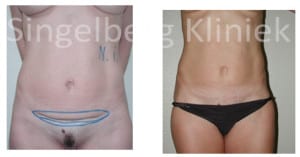Background Information on tummy tuck
Women and men who have loose abdominal skin and fat that is concentrated in the abdomen can benefit from abdominoplasty. Sometimes these conditions are inherited. In other instances, substantial weight loss may cause abdominal skin to become flaccid.
The procedure may somewhat improve the appearance of stretch marks, especially those located below the navel. The tummy tuck is an operation that is designed to remove excess skin from the abdomen at the same time abdominoplasty also can tighten muscles that have been separated and weakened by pregnancy.
It is indicated in cases where there is laxity of the abdomen resulting in bulging due to abnormal stretching of the abdominal muscles and skin. Unlike liposuction surgery, which just removes fat, this operation involves removal of skin and fat, with tightening of the abdominal muscles. For this reason, it is more extensive than liposuction. The actual extent of surgery will depend on the amount of excess skin and the laxity of the abdominal muscles.
Operation in Belgium
If you make a decision to go ahead with a tummy tuck, the actual procedure may take place in the belgian NHS Sint Jozef hospital setting where you can recover overnight.
An abdominoplasty usually takes two to three hours, depending on the extent of work required, and whether any combined procedures such as liposuction are involved. Partial abdominoplasty may take an hour or two. Partial abdominoplasty (mini tummy tuck)
During the operation, a large cut is made which runs across the lower abdomen, just above the pubic area. The skin is then separated from the abdominal wall between the incision above the pubic hair right up to the navel. Fat deposits are removed and the skin is stretched down to the incision line, with the excess skin removed before it is restitched. If the navel is not repositioned, it can be pulled into an unnatural shape as the skin is tightened and stitched.
Full Abdominoplasty (full tummy tuck) During the operation, a large cut is made which runs across the lower abdomen, usually from hipbone to hipbone, just above the pubic area. A second incision is then made to free the navel (tummy button) from surrounding tissue. Next the skin is separated from the abdominal wall all the way up to the ribcage to reveal the abdominal muscles. The muscles are then pulled and tightened and stitched into position to provide a firmer abdominal wall which provides the foundation for a slimmer waistline. Fat deposits may also be removed. The skin is then stretched down, with the excess skin again being removed. A new hole is then usually cut for your navel. Next, the navel is stitched back into place and the original incision is closed as the tightened skin is stitched back into place.
After an abdominoplasty, dressings will be applied, and a temporary tube may be inserted to drain excess fluid from the area of surgery. Firm elastic bandages are then applied to support the area.
Recovery time Depending on the extent of the procedure, you may be released to go home after a few hours, or stay in hospital for 1 or 2 days.
Some people return to work after two weeks, while others take three or four weeks to rest and recover. After Care Post-surgery advice may include: making sure that you have someone to take you home and who can look after you for at least a couple of days following this procedure; using recommended painkillers as required; needing to return for surface stitches or staples to be removed after 5 to 7 days, when lighter bandages will be applied. These will soon be replaced with an abdominal support garment which is worn for several weeks; light exercise is usually recommended as it helps with the healing process, but you must not undertake strenuous exercise routines.
Complication
Every year, many thousands of people undergo successful aesthetic surgery of the abdomen, experience no major problems and are pleased with the results.
Risks include numbness of the abdominal skin and it may take several months for the sensation to return. The surgery does produce a permanent scar which, depending on the extent of the procedure, may extend from hip to hip. Your scars may actually appear to worsen during the first three to six months as they heal, but this is normal. Expect it to take nine months to a year before your scars flatten out and lighten in colour. While they’ll never disappear completely, abdominal scars will not show under most clothing.
Like all surgical procedures, there is always a possibility of complications or side effects and, although rare, these can include infection.
Conclusion
As many of us know, the abdomen, or stomach area, is one of the most difficult places on the body for both men and women to lose weight.
Even if you are in relatively good shape, many people are bothered by a large fat deposit and loose skin in this part of the body. This can be especially so for women whose skin and muscle has been stretched by pregnancy, making it extremely difficult, in some cases, to return to the same shape that they were before giving birth.
Weight gain followed by a significant loss in weight can be another reason why the abdomen becomes rounded with loose and sometimes overhanging skin.
Depending on the amount of fat, shape of the abdomen, looseness of the skin, and strength of the muscles underneath the skin, a less aggressive procedure known as liposuction may be recommended by a surgeon. Liposuction simply sucks the fat out from underneath the skin.
However, if the skin is loose, and muscles are weak, a “tummy tuck” or abdominoplasty may help to restore your body shape. During the consultation, you will be asked about the results you would like to achieve from abdominoplasty. This will help your surgeon to understand your expectations and determine whether they realistically can be achieved.


